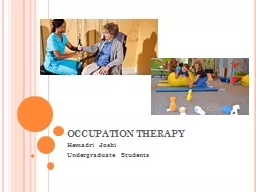

Joshi Undergraduate Students WHAT IS OCCUPATION THERAPY A form of therapy that requires and encourages rehabilitation through the performance of activities required in daily life HISTORY Began as a profession in the United States as early as 1917 ID: 777271
Download The PPT/PDF document "occupation therapy Hemadri" is the property of its rightful owner. Permission is granted to download and print the materials on this web site for personal, non-commercial use only, and to display it on your personal computer provided you do not modify the materials and that you retain all copyright notices contained in the materials. By downloading content from our website, you accept the terms of this agreement.
Slide1
occupation therapy
Hemadri Joshi Undergraduate Students
Slide2WHAT IS OCCUPATION THERAPY?
A form of therapy that requires and encourages rehabilitation through the performance of activities required in daily life.
Slide3HISTORY?
Began as a profession in the United States as early as 1917 In 1793, it was known as “moral treatment” and was an approach to cure mental illnesses.
Was a product of social environment Values based on individuals and morals
Slide4What are the requirements?
Requires a Bachelor’s Degree (now Masters as well )Specific coursework- Biology/Physiology Volunteer/Work in Occupational Therapy setting
Slide5Employment options
Hospitals Nursing care facilities SchoolsOrthopedic offices
Patients’ homes
Slide6What it takes to be a OT? (personal characteristics)
Good communication skills Problem-Solver You are friendly and kind
You must be organized You must be PATIENT You are creative and empathic
Slide7What does a daily life for an Occupational Therapist look like?
The following link will provide you an overview of how a typical day would like for an Occupational Therapist. https://
www.youtube.com/watch?v=l9idxN2-Lp8
Slide8Job outlooks
Must be licensed Six months of supervised fieldwork Taking over supervisory roles
Work exclusively with patients at home, hospital, or work environment
Slide9earnings
An Occupational Therapist earns an average of $86,000.
Slide10Wages and benefits
Wages of $35 an hour. (average) Wages of $27 per hour (low side)Wages of $46 an hour (high side)
Provide for dental insurance Medical/ sick leave PTO (personal time off)
Slide11Working conditions
Spacious rooms equipped with machines/toolsNeat and clean Bed and couches are provided to sit
Slide12Occupational therapy and acute care
Inpatient hospital setting For patients who have critical medical conditionsUsually deal with traumatic events
Slide13Code of ethics for ot
tailored to address the most prevalent ethical concerns of the profession in education, research, and practice.
promotion and preservation of the individuality and dignity of the client
Slide14What are the typical workplaces for ot
?Homes Nursing facilities
Local schools Offices Hospitals Gyms
Slide15Who do occupational therapists work with?
Children Young adults Adults
Disabled (all sorts except infants) Elderly
Slide16Activities of daily living
Eating TransfersBathing Ambulation
Toileting Dressing
Slide17Activities of daily living…(continued)
Grooming Locomotion Picking up stuff
Brushing
Slide18Correct positioning
Feet flat on the floor Ankle, knees, and hips at 90 degrees Back must be supported
Sit comfortably Bend slightly forward at waist
Slide19Initiating movement
Rocking motion with verbal stimulus “one, two, three, …go!!” Counting
Marching Music/rhythmic encouragement Auditory/visual stimuli
Slide20Initiating Movement..(continued)
Gait Rhythmical/bilateral non-resistant movements practice using foot lines with markings
Paced intervals
Slide21References
http://www.bls.gov/ooh/healthcare/occupational-therapists.htm
http://money.usnews.com/careers/best-jobs/occupational-therapisthttp://www.ithaca.edu/hshp/depts/ot/faqs/whatisot
/